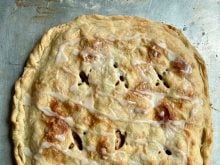During the 1970s, farmers were looking for new crops to improve their cash flow, and consumers had a variety of new cooking methods. Microwave ovens offered quicker cooking options, while fondue pots offered a more leisurely way of entertaining and eating.
Due to innovative research by Al Slinkard at the University of Saskatchewan in the 1970s, lentil varieties suitable for growing in Saskatchewan became available. The lentils’ nitrogen-fixing properties improved soil fertility. They were not sold through the Canadian Wheat Board but rather as a cash crop, which helped with farmers’ cash flow.
Read Also

Understand limitation periods if considering civil suit
A limitation period refers to the amount of time a plaintiff has to commence a formal claim in court or lose their ability to pursue it.
Sak’s Lentil Soup
Don and Judy Sakundiak were farming with Don’s family in the Lajord-Sedley area of Saskatchewan in the 1970s. Don saw a need for a seed cleaning plant in Sedley to handle the new pulse crops that had to be cleaned and bagged for shipment.
Judy, a home economist, was assisting nutritionist Alice Jenner in writing a cookbook about legumes for the Saskatchewan Pulse Crop Growers’ Association. She tested the recipes in her family’s meals.
Don, who loved food and loved to cook, created a lentil soup that was added to The Amazing Legume cookbook as Sak’s Lentil Soup. He strongly believed we should eat what we grow.
Sadly, Don passed away in 1988 from cancer. Judy continues to promote Saskatchewan grown pulse crops.
- 4 bacon strips, chopped
- 1/2 lb. ground beef 250 g
- 1/2 c. onions, chopped 125 mL
- 1 clove garlic, minced
- 6 c. beef soup stock 1.5 L
- 1 19 fl. oz. can tomato juice 540 mL
- 2/3 c. green lentils, washed 150 mL
- 1 potato, chopped
- 1/2 c. carrots, thinlysliced 125 mL
- 1/2 c. celery, sliced 125 mL
- 1/2 c. cabbage,chopped 125 mL
- 1/2 tsp. oregano 2 mL
- 1/2 tsp. basil 2 mL
- 1/4 tsp. black pepper 1 mL
- 1 tbsp. soy sauce 15 mL
- salt to taste
In a large heavy saucepan, brown bacon. Remove from the saucepan and set aside. Brown ground beef in saucepan and set aside. Sauté onion and garlic.
Return browned bacon and beef to saucepan and mix with onion and garlic. Add soup stock, tomato juice and lentils. Simmer for about 30 minutes.
Add potato, carrots and celery, simmer for an additional 20 minutes. Add cabbage, oregano, basil, pepper, soy sauce and salt to taste. Simmer until cabbage is cooked. Adjust seasonings and serve.
Makes 10 to 12 servings.
Note: You could remove the ground beef and add more lentils if desired. The taste will change slightly and more seasoning may be required.
Source: First printed in The Amazing Legume by Alice Jenner, published by the Saskatchewan Pulse Crop Growers’ Association, 1984.
Many who purchased microwave ovens in the 1970s were dazzled by the prospect of cooking foods in minutes. They didn’t realize it was a completely new method of cooking that required different techniques and timing.
Those who took classes in microwave cooking offered by the company that sold the appliance, or through community college classes, made better use of their microwaves, Liz Delahey stated in a March 9, 1979, article in the Western Producer’s Western People magazine.
Microwave Brownies
Yields: 9-12 slices.
This brownie recipe is quickly made with mixing and cooking completed in less than 15 minutes. The non-browning of cakes in a microwave is a non-issue with the instant icing on these brownies.
- 1/2 c. butter, melted 125 mL
- 2 eggs
- 1 c. sugar 250 mL
- 1/2 tsp. salt 2 mL
- 1 tsp. vanilla 5 mL
- 3/4 c. flour 175 mL
- 1/2 c. cocoa 125 mL
- 1 c. chocolate chips 250 mL
- 1/2 c. chocolate chips 125 mL
- 1 c. nuts, chopped 250 mL (optional)
Melt butter in 8 x 8 inch (20 x 20 cm) square or round microwavable cake pan. Microwave one minute to melt butter, tip around pan to coat the bottom and sides.
In a small bowl, beat together eggs, sugar, salt and vanilla at medium speed for about one minute until light or use a fork and whip.
Add melted butter, mix in. Add flour and cocoa, mix all together, add first amount of chocolate chips and nuts. Spread out in pan.
Microwave for one-minute intervals, turning dish a quarter turn after each minute, for three to six minutes until centre bubbles up but is still glossy. Don’t overcook. Before the last minute of cooking, sprinkle the second amount of chocolate chips, cook for 30 to 60 seconds, then spread melted chocolate chips over the top. Cut when cool. This recipe is based on a 1,200 watt microwave. Lower wattage ovens will take longer to cook the brownie.
Note: This recipe is a family favourite that has been used for years.
Adapted from The General Electric Microwave Guide & Cookbook, 1977
In her March 15, 1973, article, Emmie Oddie had a reader who asked for recipes for the fondue pot she had received as a Christmas gift. Fondue pots were new on the market in the early 1970s. They introduced a way to leisurely enjoy a meal, an appetizer or a dessert.
Oddie explained that cheese fondue originated out of necessity. In Switzerland cheese was made during the summer and fall and had to last the whole year. The cheese would become so hard that it was almost impossible to eat. As a result, the cheese was melted and used as a dunk for broken pieces of hard bread.
To enjoy a fondue, place the pot in the middle of the table and have four to six people spear chunks of bread on long skewers or fondue forks and dunk the bread in the cheese one at a time.
Swiss Fondue
Serves six to eight.
- 1 clove garlic
- 2 c. dry white wine*
- 1/2 lb. Emmentaler cheese, finely shredded **
- 1/2 lb. Gruyere cheese, finely shredded **
- 3 tbsp. cornstarch
- 3 tbsp. kirsch*
- nutmeg or pepper or paprika
- French bread
*Two cups apple juice may be substituted for the wine and three tablespoons of lemon juice can be used instead of kirsch.
** The Emmentaler and Gruyere cheeses may not be easily found in rural communities. Alternative cheeses are:
- 1/2 lb. gouda, shredded
- 1/4 lb. Swiss, shredded
- 1/4 lb. medium cheddar, shredded
Pour wine into a saucepan and place over low heat. When bubbles rise (not boiling), add cheese a spoonful at a time, stirring constantly with a wooden spoon. Stir until all the cheese is melted. Blend cornstarch and kirsch and slowly stir into mixture. Add spice to taste. Stir until smooth and thickened.
Rub the inside of an earthenware fondue dish with garlic. Pour hot cheese mixture into the dish and serve with pieces of French bread, cauliflower, broccoli, apple slices, or cured meats.
This recipe can also be prepared in the microwave oven at low intensity and stirring frequently.
Meal fondues general consist of hot oil in a fondue pot into which chunks of meat on long forks are dipped.
Chocolate Fondue
This is a fun and easy dessert.
- 1 c. semisweet chocolate chips
- 1/2 c. light corn syrup
- 1 tsp. vanilla
Combine over hot (not boiling) water. Stir until chocolate melts and mixture is smooth. Remove from heat and keep warm over hot water or with a warming candle.
Dip marshmallows, pineapple cubes, banana chunks, fresh apple slices or drained oranges, using wooden skewers. The chocolate could be melted in the microwave on a medium power, using 30 second intervals.
In a May 4, 1972, article that referenced the Consumer Reports magazine, a warning was issued about the fire hazards of open-flame fondues, especially if accidentally tipped over. In the case of meat fondues, the oil is extremely hot and can cause sudden and serious injury.
Consumer Reports recommended the purchase of stable electric fondues or canned jellied alcohol burner types rather than the more hazardous liquid. It also recommended checking the stability of the pot.
It is interesting to note that during the 1970s, food prices were increasing. In 1979 alone, food costs rose 19 percent. There were several articles during the decade on how to save money when grocery shopping.
Betty Ann Deobald, one of The Western Producer’s TEAM Resources columnists, will write a monthly column for the next year examining rural life in each decade of the last century.


















